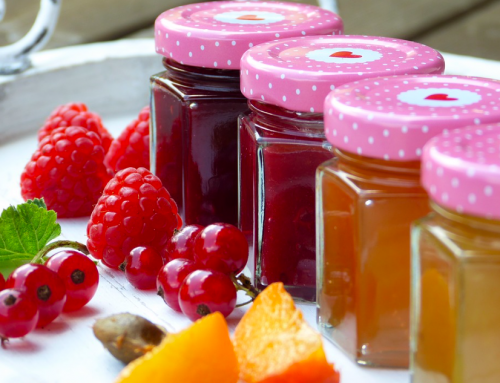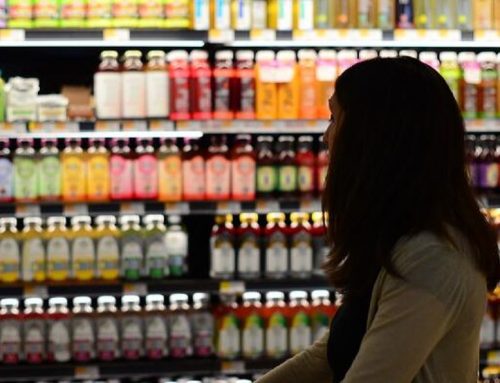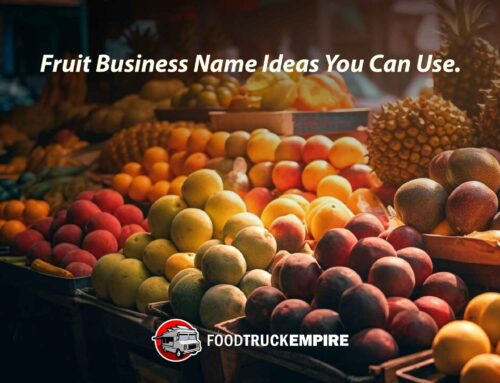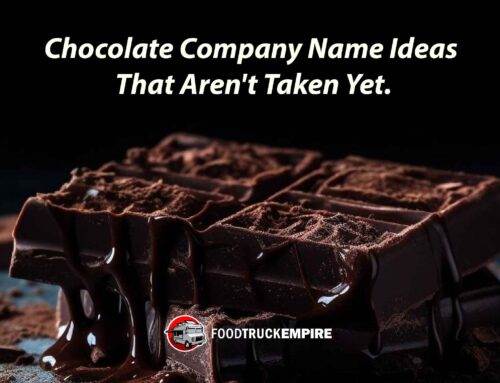I’ve gotten a ton of emails from readers asking about shipping their food products. I always thought it was terribly easy, but not everyone has been packing online and retailer orders for six years. Ok, some of you have been packing orders for decades.
Regardless, the same rules apply: Get it there on-time and without damage. Oh, and do it affordably. The cost can get out of hand when you ship coast-to-coast.
In this post, I’ll walk through everything you need to ship your food products. This includes packaging your product in case boxes, shipping online orders, handling retail and large pallet orders to distributors or large retail warehouses. I also answer to a few frequently asked questions I get about the shipping process at the end of the guide. Let’s get started!
Packaging in Case Boxes:
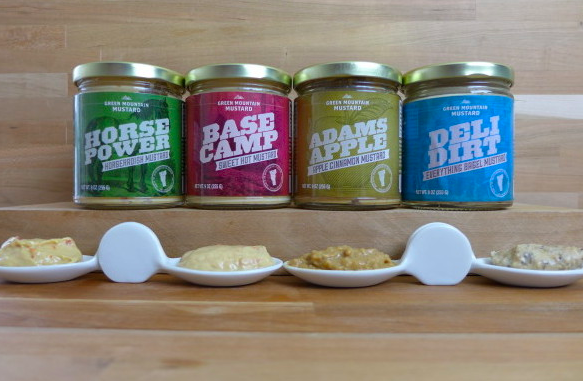
My line of mustard.
Many food producers get a case box when they purchase their glass. That’s super convenient because you can slap a product label on the box and move onto the next one. The other bonus? When you empty a case, you can use the box as a shipping box or void-fill when you ship orders (see below).
But, if you buy your glass in bulk, many times the containers come loosely-wrapped on a pallet with a corrugated sheet in-between several layers of glass bottles. It’s definitely cheaper to buy this way, but during shipping many of the bottles will shatter due to improper handling and sometimes sudden temperature changes.
Attention Founders: Download our food business startup kit with business canvas, startup spreadsheets, and exclusive interviews.
Buying your glass loose means you have to find your own corrugated case box. I’ve written previously about choosing the right case pack and starting a food company, so I won’t get into that here. Basically, you need to find a box with dividers to hold 6 or 12 finished units.
Case box prices will fluctuate. The box and the insert are often quoted separately. The more you order, the lower the price. Many businesses choose to add their logo, a checkmark for the flavor that’s in the box, and a UPC code. If you decide to move forward, Unicorr and Lakeside Container are my recommendations in the Northeast US.
Shipping Your Wholesale Orders
Now that you have your case boxes sorted out, it’s time to start shipping case all around the country. Figuring this out, believe it or not, is actually quite a challenge. Do you add bubble wrap – how much? How do you figure out the size of your outer-case box? Where do you get your shipping materials?
There are so many questions that need answers! Don’t worry, I’ll take it in baby steps.
Shipping Materials
I used to buy everything from ULINE – bubble-wrap, packing peanuts, tape, etc. Then, last year, two things hit me: I can get supplies faster and cheaper through Amazon. And, I can ask my friends and neighbors for their shipping materials. With that mix, I saved a ton of money last year – and I continue to use recycled packaging materials.
Figuring Out Shipping Boxes
This took some graph paper, so go grab some if you’re trying to figure this out. Figure out how you’d like to ship orders. How many cases are in each order? I have shipping boxes for 1, 2, 4, and 6 cases. If an order is larger, I’ll use multiple boxes. It’s maybe not the most economical, but then I don’t have to order another shipping box.
Related Reading: Recipe Cost Template – Download My Spreadsheet
To determine your box size, stack cases how you’d like to pack them. (Ex. 2 cases x 2 cases for a 4 case box), and add a 1/2″ to an 1″ on all sides for packing material. Then, you have your box size. Check Uline or your local box supplier to make sure they have what you’re looking. You can usually order in bundles of 25 boxes so it’s not too expensive. Watch out for the extra shipping charge – it’ll get you!
I use bubble wrap to go around all edges and layers of my case boxes. So, for a 4 case shipment, I’m using 20 sheets of bubble wrap. I’m probably out of my mind – I know.
FedEx or UPS?
It’s the age-old battle of the titans here. I’ve shipped with both shipping companies. For me, FedEx wins hands-down. I’ll ship UPS if a customer requires it. To me, UPS breaks almost every package I ship, resulting in a ton of wasting time filling out claim forms and sending pictures. FedEx on the other hand? I’ve had one package break in six years.
And, here’s the BIG reason I choose FedEx: If you’re a member of the Specialty Food Association, you can sign up for Partnership.com and get not only 20% off FedEx Ground rates, but you can get free freight quotes for large orders (see below). It has saved me almost $1,000 since I signed up. So put that in the win column.
Shipping Pallet Orders
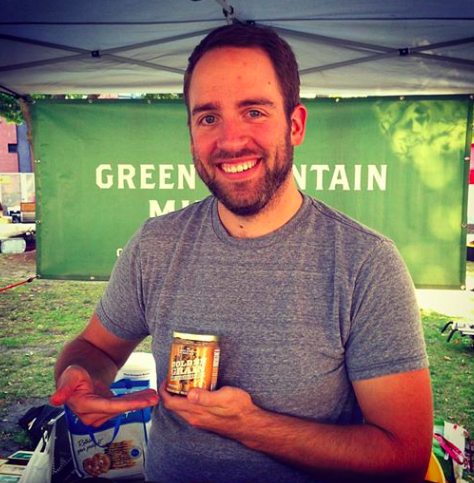
I’ve shipped a lot of mustard in my day.
Shipping pallets for the first time is one of the most exciting (and overwhelming) parts of starting your food business. It’s tons of inventory being shipped to some mystery warehouse. I’d be nervous, too. What if it doesn’t make it? Thankfully, just like smaller shipments, there are tracking numbers. Let’s walk through how I ship a pallet order.
How many cases fit?
A normal pallet is 40″ x 48″ – wood or plastic. The first step is to determine how many cases can fit on a pallet. If you want to do a mock shipment, seek out a used pallet on Craigslist. They’re all over the place. You can do this by measuring your cases and dividing by the width and length. Then, you can figure out how to lay the first layer.
Here’s a free pallet builder that will show you. Once you have the first layer, you can either stack directly on top or rotate the layer so it’s staggered. Typically, I’ll stack a pallet 10 cases high. It’ll get pretty heavy, and you want to make sure the forklift at your warehouse (or trucking company) can handle it. The last pallet I moved was 3,000 pounds and man, it was a challenge – even for an electric forklift.
Wrapping a pallet?
Once you’re all stacked up, let’s wrap this puppy. Make sure there isn’t a lot of overhang on your pallet because trucking companies like to put other pallets next to (and potentially on top of) your pallet. If you have cases sticking out, it makes their job much harder.
You can find pallet wrap on ULINE. Make sure to get some handles because wrapping a pallet with just the wrap in your hands hurts. And you get dizzy. So let’s make this as comfortable as possible, right? Alternatively, you could pay your warehouse to wrap the pallet, but I’m thinking many of you don’t have your own warehouse.
If you’re worried about your cases still crashing to the ground, you can put edge protectors, cut-to-size, on all the corners. This helps keep your pallet from shifting. And believe me, I’ve seen some pallets shift, no matter how tightly wrapped they are.
How to wrap the pallet:
- Take some pallet wrap and loop it around one corner of the pallet.
- Tie that wrap in a knot to give yourself a secure corner and anchor point.
- Wrap the very bottom (the wood part) in wrap 2-3 times to secure the base.
- Then, slowly start to overlap your layers, moving up the pallet until you get to the top.
- Once at the top, wrap a corner and create an “X” pattern across your cases to secure the top.
- Rip the wrap off and you’ve got yourself a wrapped pallet.
Those are written instructions, but here’s a YouTube video (watch it on mute because the background music is awful):
Preparing Your Pallet for Shipping
Just like with any package, you have to tell the freight company where it’s going. In Microsoft Word, create a large print TO and FROM area that includes a Purchase Order number (PO), if applicable and your phone number. Attach this paper to all four sides of your pallet with packing tape.
You’ll also have a Bill of Lading (BOL) that you’ll have to fill out. This is for the truck driver to trace the shipment from pick-up to drop-off and for his company to know he’s got the freight on his trailer. Every company has a different BOL format, but make sure to fill it out before the truck is at your door.
Finding Rate Quotes & Using Freight Brokers

Get quotes from multiple shipping companies.
If you thought shipping online orders was cutting into your cashflow, you may have never shipped a pallet. Generally, if you’re shipping 1-2 states over, you’re probably looking at $100 – $250 to ship the pallet. Obviously, as your destination gets further away, the rate increases.
To find quotes, you can use Partnership.com, TQL, or deal with the trucking company directly. I’ve found some of the best rates (in New England at least) come from LandAir (in-state shipments), Road Runner, New England Motor Freight, and R+L carriers.
Freight brokers, like TQL (Total Quality Logistics) help you find the best rate possible. They take all of your shipment information and send it out for quotes to all kinds of trucking companies and come back with a reasonable rate. Now, the secret here is to use multiple freight brokers. Don’t be afraid to get a quote from 2 or 3 freight brokers and pit them against each other. Ultimately, you end up with a great quote and somebody wins the business.
It’s just like labels. You get quotes from 2 or 3 label printers and go with a printer based on quality, location, and price – oh, and friendliness. Nice label printers are the best.
Freight quoting is a science – they need to know your pallet weight (case weight x number of cases + 40 pounds or so for the pallet), where it’s being picked up, shipped, the contents, and any special requirements. I wish you nothing but good luck navigating these waters. If anyone has tips for shipping pallets, please leave them in the comments below to help out the community.
Shipping Online Orders

The only downside to online orders is the shipping.
Here we go. Something near and dear to my heart. Good old online orders. I’m sure some of you love them. And I’m sure some of you hate them. The truth, however, is that they exist. And it’s a growing segment for all businesses – not just food. If you’re still in your basement or dining room shipping out orders, I feel you. If you outsource this – whether through employees or a 3rd party fulfillment company – I’m super jealous.
I’m sure the way I ship online orders can be improved, but for the time being, here’s how I ship any order that comes through my online store:
It starts with an awesome e-commerce platform. We use Shopify and I will never use anything else. It’s simply the best – and it’s affordable at only $29/month. In fact, there’s a 14-day free trial so you can test-drive it. They have free and paid themes, and a million apps to customize your store as you see fit. The platform integrates with many shipping systems like FedEx, UPS, and USPS, or you can set your own shipping rates.
For reference, we’re currently shipping at $7.99 flat-rate and free shipping over $50. I used to run free shipping over $30 and would lose money all. the. time. Now, sometimes, we actually make some money on the flat rate of $7.99.
We process all of our shipping labels online through USPS.com or FedEx.com. I’ve you’ve ever stood in line at the post office the weeks leading up to Christmas, you’d print online, too. That way, you save money – and you get to skip the line and drop your packages off before everyone else.
Easily 90% of my shipments are USPS. Seeing as we only have one jar size, it’s relatively easy to figure out how to pack jars into certain boxes:
- 1-4 jars fit, individually bubble-wrapped in these Local Rate A Boxes from the USPS
- 5-12 jars fit in these Local Rate B Boxes from the USPS. When it’s 5-7 jars, I individually wrap them. When it’s 8+ jars, I’ll put them in a case with packaging peanuts to fill the void, and ship it out. It’s an inexpensive way to send 13 pounds worth of mustard anywhere in the Northeast.
Pro tip: I do not ship USPS when the order is being shipped far from Vermont or it’s over 15 pounds. Then, I’ll ship FedEx Ground because it turns out it’s cheaper. Yay!
I fulfill my own online orders because I have control over the experience. You could use a 3rd party fulfillment center but then you get into eroding margins and it gets messy. The benefit of shipping my own orders is I get to include a hand-written thank you note in every order, along with the order slip, a business card, and some recipes. It’s often what gets posted on Instagram. Why? Because it just doesn’t happen anymore. People don’t handwrite anything.
Related Reading: My Complete Guide to Profitable Co-Packing
I should also say that, before I ship an order, the customer gets an automated shipping confirmation that asks them to reply “heck yes!” if they’re excited to receive their mustard. Plus, I ask them where they heard about me and include a picture of my family. You see, people buy from people. The stronger the human connection, the better.
When the orders pile up, I truck them directly to the post office. They can come pick everything up, but I like inundating the postal clerk with boxes.
Pro Tip: Create a System
In the summer months, shipments seem to go out every which way – retail deliveries, online orders, you name it. It helps to create a system for you and your team (or in my case, my parents). They help ship out online orders. We have a sheet in the basement that shows what’s included in all gift packs as well as when to use each box and how to ship it. Do you have a system that works best for you?
Conclusion: In the end, understanding how to ship your products is different for every company – size, weight, and cost have a lot to do with how certain strategies pan out. Good luck with your shipping strategies. Hopefully you found some tips here!
Frequently Asked Questions about Shipping Food
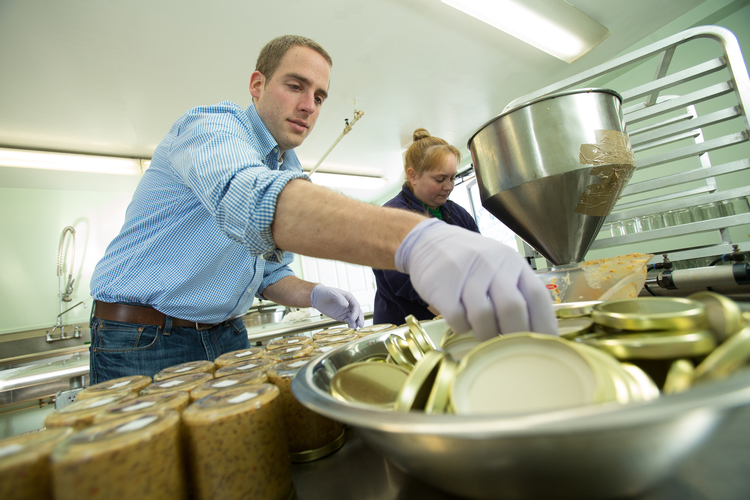
Tips based on my own experience in the business.
Question: How do I ship beverages or food items that need to stay cold at all times?
Answer: You’ll want to use refrigerated distribution. Often times is a service in your area. You can also package food or beverages in boxes with ice that serve as a shippable cooler. Or, if you self distribute, large coolers in the back of a van or build something similar to an ice cream truck with freezers onboard.
Answer: Frozen is hard — you need an insulated shipper and some dry ice. I’d work with a packaging/box company to assess your individual needs and go from there.
Your best bet is to purchase insulated shipping boxes with the dry ice. You can often find these cheaper from local packaging suppliers than from online sellers. For example, ULINE has them but shipping will kill you.
Question: I would like to know if you bubble wrap the glass jars that are in the boxes of 12 (individually) or if you just bubble wrap around the outside box?
Answer: When I ship a case, the case box fits right into a Local Rate B box from USPS – then I have 6 pieces of bubble wrap around it. Two on the bottom, one on each side, and 2 on the top with the order confirmation. This method has only failed me once.
Question: It is worth looking into custom boxes? I bet you will save on the additional packaging materials as well since you will need less with a custom box.
Answer: ULINE is kind of a pain when they don’t have what you want, I’ll look into MrBoxOnline.com.
I hope this guide answered your toughest questions about the food shipping process. If you enjoyed this post be sure to check my download and complete my food business canvas.

